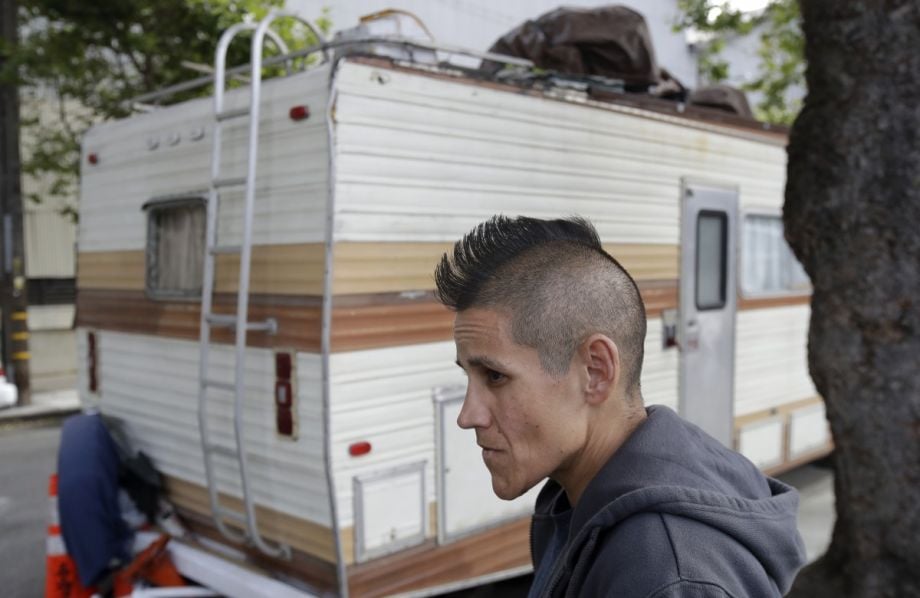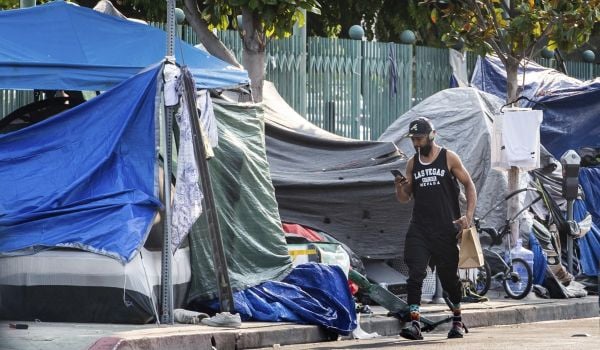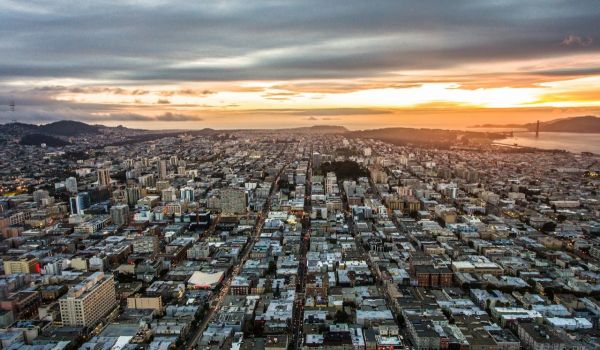In late October, San Francisco mayor London Breed announced plans for a safe parking site for people living in their RVs housed at Candlestick Point State Recreation Area in the Bayview-Hunter’s Point neighborhood. The planned site will include 150 parking spaces with a capacity for 177 residents and will have electricity, lighting, 24-hour security, bathrooms, drinking water and blackwater pumps to handle RV waste. The site — formally called a “vehicle triage center,” will also include case management and housing services intended to move people into permanent housing.
The strategy is partially a response to an accelerated trend of people living in their vehicles during the pandemic. In November, there were 673 people living in RVs, campers, and vans and another 332 living in passenger vehicles across San Francisco, according to city data. In January 2020, those numbers were 554 and 260 respectively.
For people who have no other shelter, living inside a vehicle provides protection from the elements, heat, a place to sleep, cook and use the bathroom. But the approach has drawbacks; finding potable water is difficult, and RVs produce waste that is difficult to discard, leading to complaints from neighbors. And city officials frequently ticket or tow vehicles that people are living in. The city’s parking laws — including a ban on parking on a public street for more than 72 hours - make it easy for people living in their vehicles to rack up tickets. Five or more unpaid tickets can lead to a car or van being towed, sometimes called “poverty tows” because they disproportionately affect people sheltering in their vehicles.
The new site will provide a safe, sanctioned place for people to park, as well as resources, which the city is hoping will lead to more people connected with resources and less complaints about debris and waste. But the city is also doubling down on enforcement to deal with RVs outside the park.
And the planned site will be temporary — the city has not stated how long it will last, but is negotiating a two-year lease with the state parks department for the land. Advocates for people housed in vehicles are concerned this won’t be long enough to permanently house people — and troubled the city has already made an arrangement to tow and ticket nearby RVs when they roll out the safe RV site. The San Francisco Chronicle reported that the city has forged an agreement with the state parks department, which owns the land the city will be leasing, to increase police presence in the park and tow vehicles on roads adjacent to the park.
“With any program that they open, it comes with enforcement, because that’s how the system does it,” says Kelley Cutler, an organizer with the Coalition on Homelessness San Francisco.
Whether the site at Candlestick Park will be able to help residents into permanent housing remains to be seen. A previous Vehicle Triage Site in San Francisco operated from November 2019 to November 2020 and showed mixed results, according to a report from the city comptroller’s office. The site, which was also overseen by San Francisco’s Department of Homelessness and Supportive Housing (HSH), provided 29 parking spots home to 75 people at 2940 San Jose Avenue, near the Balboa Park BART State, at a total cost of $1.6 million. The city contracted with a nonprofit that provided laundry, shower and security services.
Fifty-seven percent of the San Jose Avenue site’s residents were eligible for subsidized housing and the rest were connected with case managers who tried to re-house the guests through “problem-solving,” including job placements, small grants and establishing contact with family members. But the report says only 25 percent of the residents were placed into housing throughout the year. 8 guests were transferred to or shelter in place hotels due to health issues. And 7 people — totalling 3 households — were asked to leave the site due to behavioral problems from members of their households.
Next City requested clarification from HSH regarding the aforementioned behavioral problems but did not receive a response at the time of publication.
Despite the promise that the site will lead to a decrease of illegal dumping of RV waste — long an issue around the park — the planned site has predictably raised the ire of locals, who believe it will prolong the presence of RV encampments. (Advocates, however, say local opposition to people living in RVs is driving increased enforcement, which has displaced vehically housed residents and prolonged homelessness.)
The Bayview-Hunter’s Point neighborhood has historically faced underinvestment; it was redlined in the early twentieth century when it was predominantly Black; in 1963, the author James Baldwin made a documentary about its Black residents, highlighting substandard housing and industrial pollutants. In the 90’s and 2000’s, much of the Black population was displaced by redevelopment. Some local opponents of the site have cited this history as evidence that the neighborhood is being treated as disposable.
“Originally we thought a vehicle triage center was a good idea, but we didn’t know it was going to be at the state park, and that is just a terrible place for it,” says Marsha Maloof, the president of the Bayview Hill Neighborhood Association, which opposes the site. Maloof says that the neighborhood and the state park suffer from underinvestment and that the community had fought for years to keep it open. It still suffers from a lack of trash pickup and non-functioning restrooms, she says.
She said the city could bring resources to where RVs are currently parked, rather than move them to the park.
Maloof and the neighborhood association have had conversations with Mayor London Breed, San Francisco Board of Supervisors President Shamann Walton and with the city planning commission, but says none seemed open to changing the location of the site.
“The Vehicle Triage Center at Candlestick Point will provide a level of services and safety that is needed for the people living in their vehicles in the area,” Mayor Breed said in a press release.
Gwendolyn Westbrook, director of United Council of Human Services, is vying for the contract to provide services at the Candlestick Point safe parking site. She says the opposition to the safe RV site on the basis of the neighborhood’s history makes little sense, as the RV site will make the site cleaner and is intended to permanently house longtime residents. She also says the people currently parked near the park are longtime San Francisco residents who were displaced for affordability reasons, and many are from the Bayview.
“They don’t know what they’re talking about, basically,” Westbrook says of opponents to the safe parking site. “The people out there are from San Francisco. They went through the gentrification out here and people ended up on the streets,” she says. Some of the people who live in the encampment are folks she went to high school with, and some have been living in a vehicle in the neighborhood for 15 years, Westbrook says.
Westbrook hopes the city keeps the Candlestick Park site up long enough for people to be rehoused.
“I’m hopeful that they can keep it until they can get people placed in housing, because what’s the whole point of doing all this, and then you close it down and the people are still there?” she says. Westbrook added that it may take time for the city to build enough low-income housing to place residents.
According to Cutler with Coalition on Homelessness, who also served on the oversight board for the San Jose Avenue safe parking site, the difficulty in transitioning people to housing is a sign that there isn’t enough available affordable housing to “triage” people, in the city’s parlance. Cutler says the data from the San Jose Avenue pilot is also skewed by the selective criteria used for the site. According to the comptroller’s office, the site found clients by flyering through its Homeless Outreach Team; people eligible for subsidized housing or other benefits were prioritized, as were people with health issues stemming from long-term RV life. (The Candlestick Point site will also be invitation-only, which the city says is important for preventing more RVs from congregating from outside the neighborhood, which it called a “magnet effect.”)
“They basically cherry-picked who got in, and the others just didn’t qualify, and the rates of getting folks connected from there into housing wasn’t great,” Cutler says. In looking for people who qualified for housing, the program risks leaving people out, Cutler says. “Within the vehically housed population it’s very diverse, you’ve got families, seniors, folks who are employed, a lot of people under this umbrella that are living in vehicles.”
The increase in enforcement despite a lack of official services is an issue the Coalition on Homelessness has taken on in the past. In one recent report, the nonprofit accused the Healthy Streets Operating Center, the city’s multi-agency taskforce in charge of clearing encampments, of conducting sweeps whether or not there were available resources for the people being asked to leave. This would violate Martin v Boise, which held that officials can’t clear homeless encampments without available shelter resources.
“I can’t tell you how many times people have asked for just this magic card that you can hand someone who is unhoused,” Cutler says. “It’s not that people are service resistant, it’s that there’s very few resources.”
Cutler says there is a link between community pushback like that of the neighborhood association and enforcement; it often results in the city increasing enforcement any time new homeless services, like a shelter or a navigation site, open. And even though programs like the safe parking site are temporary, she says restrictions tend to remain long after they are gone.
“No matter where you go in the city to try and create any resource for folks who are unhoused it’s a battle,” Cutler says. “To kind of ease the current residents’ minds they continue to bring in more law enforcement. This isn’t a law enforcement issue.” She says vehicle communities are constantly being displaced because of neighborhood complaints, only to congregate in a new neighborhood where they are eventually evicted. “This has been going on for years and years,” she says.
For now, the city is pushing on with the plan for a temporary safe RV site and increased enforcement and is aiming for a January 2022 start date. In early November, the city also rolled out an emergency RV site at 1236 Carroll Avenue for people living in vehicles along Hunters Point Expressway who were impacted by recent storms. That park will remain open until the Candlestick Point site is ready, the city says.
Cutler says overall the plan to provide people with resources is a good one.. “Any alternatives where someone can simply just park somewhere and not have to worry about their home being stolen while they’re at work or while they’re at a doctor’s appointment, that’s moving in the right direction,” Cutler says. She warns however that it is a misnomer to label it a triage center, as it implies people will all transition directly to permanent housing. “That’s just not the reality, the reality is that it’s going to take time.”
Editor’s note: After press time, San Francisco’s Department of Homelessness and Supportive Housing (HSH) provided Next City with a copy of the RFP for the safe parking site, which states that the site will employ a staff of 4 caseworkers and a case manager and will provide referrals to mental health, benefits assistance, and job services.
In response to questions about people who were asked to leave, HSH said they could not comment on specific cases but cited a list of potential violations, including refusing to comply with mask mandates, acts of violence, “disruptive behavior” that is a clear risk to others, possessing a weapon and property destruction.
This article is part of Backyard, a newsletter exploring scalable solutions to make housing fairer, more affordable and more environmentally sustainable. Subscribe to our weekly Backyard newsletter.

Roshan Abraham is Next City's housing correspondent and a former Equitable Cities fellow. He is based in Queens. Follow him on Twitter at @roshantone.


















